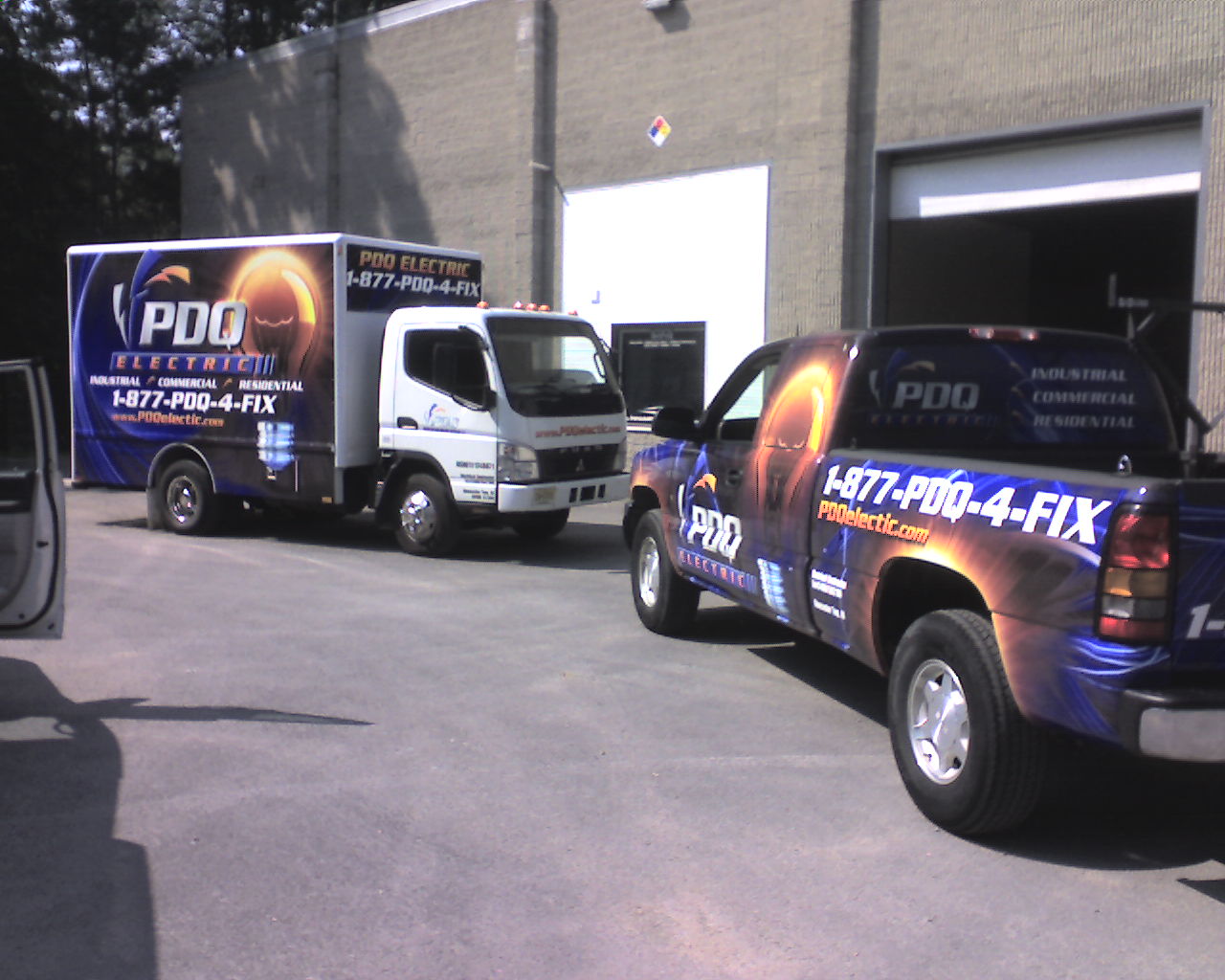 Industrial - Commercial
Industrial - Commercial  Electrical
Contractor
Electrical
Contractor 
PDQ Electric Corp
NJ, PA, DE, MD, NY, CT, DC, MA, RI
|

PDQIE - PDQ Industrial ElectricArc Fault Flash AnalysisAn arc flash (or arc blast) is a type of electrical explosion that results from a low impedance connection to ground or another voltage phase in an electrical system. DEFINITIONAn arc flash is an electrical breakdown of the resistance of air resulting in an electric arc which can occur where there is sufficient voltage in an electrical system and a path to ground or lower voltage. An arc flash with 1000 amperes or more can cause substantial damage, fire or injury. The massive energy released in the fault rapidly vaporizes the metal conductors involved, blasting molten metal and expanding plasma outward with extreme force. A typical arc flash incident can be inconsequential but could conceivably easily produce a more severe explosion (see calculation below). The result of the violent event can cause destruction of equipment involved, fire, and injury not only to the worker but also to nearby people. In addition to the explosive blast of such a fault, destruction also arises from the intense radiant heat produced by the arc. The metal plasma arc produces tremendous amounts of light energy from far infrared to ultraviolet. Surfaces of nearby people and objects absorb this energy and are instantly heated to vaporizing temperatures. The effects of this can be seen on adjacent walls and equipment - they are often ablated and eroded from the radiant effects. EXAMPLESIn general, arc flash incidents are highly improbable on systems operating at less than 208 volts phase to phase (120 V to ground) when fed by less than a 125 kVA transformer, as 120 volts does not provide sufficient energy to cause an arc flash hazard. Most 480 V electrical services have sufficient capacity to cause an arc flash hazard. Medium-voltage equipment (above 600 V) is higher energy and therefore a higher potential for an arc flash hazard. As an example of the energy released in an arc flash incident, consider a single phase-to-phase fault on a 480 V system with 20,000 amps of fault current. The resulting power is 9.6 MW. If the fault lasts for 10 cycles at 60 Hz, the resulting energy would be 1.6 megajoules. For comparison, TNT releases 2175 J/g or more when detonated (a conventional value of 4,184 J/g is used for TNT equivalent). Thus, this fault energy is equivalent to 380 grams (approximately 0.8 pounds) of TNT. The character of an arc flash blast is quite different from a chemical explosion (more heat and light, less mechanical shock), but the resulting devastation is comparable. The rapidly expanding superheated vapor produced by the arc can cause serious injury or damage, and the intense UV, visible, and IR light produced by the arc can temporarily and sometimes even permanently blind or cause eye damage to people. PROTECTING PERSONNELThere are many methods of protecting personnel from arc flash hazards. This can include personnel wearing arc flash personal protective equipment (PPE) or modifying the design and configuration of electrical equipment. The best way to remove the hazards of an arc flash is to de-energize electrical equipment when interacting with it, however de-energizing electrical equipment is in and of itself an arc flash hazard. In this case then one of the newest solutions is to allow the operator to stand far back from the electrical equipment by operating equipment remotely. ARC FLASH PROTECTION EQUIPMENTWith recent increased awareness of the dangers of arc flash, there have been many companies that offer arc flash personal protective equipment (PPE). The materials are tested for their arc rating. The arc rating is the maximum incident energy resistance demonstrated by a material prior to breakopen or at the onset of a second-degree skin burn. Arc rating is normally expressed in cal/cm2 (or small calories of heat energy per square centimeter). The tests for determining arc rating is defined in ASTM F1506 Standard Performance Specification for Flame Resistant Textile Materials for Wearing Apparel for Use by Electrical Workers Exposed to Momentary Electric Arc and Related Thermal Hazards. Selection of appropriate PPE, given a certain task to be performed, is normally handled in one of two possible ways. The first method is to consult a hazard category classification table, like that found in NFPA 70E. Table 130.7(C)(9)(a) lists a number of typical electrical tasks are various voltage levels and recommends the category of PPE that should be worn. For example when working on 600 V switchgear and performing a removal of bolted covers to expose bare, energized parts, the table recommends Category 3 Protective Clothing System. This Category 3 system corresponds to an ensemble of PPE that together offers protection up to 25 cal/cm2 (105 J/cm2 or 1.05 MJ/m2). The minimum rating of PPE necessary for any category is the maximum available energy for that category. For example, a Category 3 arc-flash hazard requires PPE rated for no less than 25 cal/cm2 (1.05 MJ/m2). The second method of selecting PPE is to perform an arc flash hazard calculation to determine the available incident arc energy. IEEE 1584 provides a guide to perform these calculations given that the bolted fault current, duration of faults, and other general equipment information is known. Once the incident energy is calculated the appropriate ensemble of PPE that offers protection greater than the energy available can be selected. PPE provides protection after an arc flash incident has occurred and should be viewed as the last line of protection. Reducing the frequency and severity of incidents should be the first option and this can be achieved through a complete arc flash hazard assessment and through the application of technology such as high resistance grounding which has been proven to reduce the frequency and severity of incidents. REDUCING HAZARD BY DESIGNThree key factors determine the intensity of an arc flash on personnel. These factors are the quantity of fault current available in a system, the time fault until an arc flash is cleared, and the distance an individual is from an arc. Various design and equipment configuration choices can be made to affect these factors and in turn reduce the arc flash hazard. FAULT CURRENTFault current can be limited by using current limiting devices such as grounding resistors or fuses. If the fault current is limited to 5 amperes or less, then many ground faults self-extinguish and do not propagate into phase-to-phase faults. ARCING TIMEArcing time can be reduced by temporarily setting upstream protective devices to lower setpoints during maintenance periods or by employing zone-selective interlocking protection (ZSIP). Arcing time can significantly be reduced by protection based on detection of arc-flash light. Optical detection is often combined with overcurrent information. Light and current based protection can be set up with dedicated arc-flash protective relays or by using normal protective relays equipped with arc-flash option. The most efficient means to reduce arcing time is to use an arc eliminator that will extinguish the arc within a few milliseconds. DISTANCEThe distance from an arc flash source within which an unprotected person has a 50% chance of receiving a second degree burn is referred to as the "flash protection boundary". Those conducting flash hazard analyses must consider this boundary, and then must determine what PPE should be worn within the flash protection boundary. Remote operators or robots can be used to perform activities that are high risk for arc flash incidents, such as inserting draw-out circuit breakers on a live electrical bus.
Did You Know?Non-invasive Thermography can be done through an Optical Inspection Window, Infrared Viewing Port, in an Infrared Transmissive Electric Panel Cover. Contact PDQ Industrial Electric (877) PDQ-4-FIX to Schedule Your Arc-Flash Survey | |
(877) 737-4349 (Toll Free)
(877) PDQ-4-FIX (Toll
Free)
(856) 625-6969 (Text
Messaging)
PDQ ia an Acronym for "Pretty Damn Quick"
|
PDQIE, www.PDQIE.com, info@PDQIE.com, quote@PDQIE.com, Ryan@PDQIE.com, PDQ Industrial Electric, www.PDQIndustrialElectric.com, info@PDQIndustrialElectric.com, quote@PDQIndustrialElectric.com, Ryan@PDQIndustrialElectric.com are marketing tools of PDQ Electric Corp, a NJ Licensed Electrical Contractor. Reddy Kilowatt® is a Registered Trademark of Northern States Power Company. The information on this website is believed to be reliable, but we cannot guarantee that information will be accurate, complete and current at all times and should be reaffirmed by a licensed professional before relying on it. PDQIE will from time to time revise information, products and services described in-on this Website, and reserves the right to make such changes without notice. Use of this Website is entirely at your risk. Materials and information in this Website (including text, graphics, and functionality) are presented without express or implied warranties of any kind and are provided "as is". It is your responsibility to evaluate the accuracy, completeness and usefulness of any opinions, advice, services and information provided.
